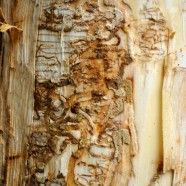Survey Work Continues
Call us crazy, but we have done it again: bundled ourselves up and trudged around in knee deep snow to survey for the deadly Hemlock Woolly Adelgid. This time, our JCC/CWC/RTPI survey team traveled down to Warren County to visit the Hatch Run Conservation Demonstration Area for the second year in a row. This site is loaded with Eastern Hemlock trees that make up a beautiful and valuable riparian zone between the streams and upland forests. We are happy to report that we didn’t find the pest we were after (which is a good thing!) and being in that particular site made us really think....
Read MoreSuccessful 1st Survey
I am very happy to report that our team comprised of RTPI staff and JCC faculty and students did not find Hemlock Woolly Adelgid (HWA) on any of the 200+ trees we surveyed at South Valley State Forest! Although the temperatures were chilly, we had a beautiful sunny day to be out in the hemlock stands trudging our way through the knee deep snow. Prior to our survey we ran our student surveyors through background information about this deadly invasive bug threatening the area’s hemlock trees. We went over look-alikes and our field protocol, then headed out the door to our destination....
Read MoreHWA Surveys Set to Begin
This winter season the Roger Tory Peterson Institute of Natural History, Jamestown Community College and Chautauqua Watershed Conservancy are teaming up to survey for Hemlock Woolly Adelgid (HWA) at a number of sites within Chautauqua County. The public is welcomed to join in the survey efforts and will receive on-site training encompassing general information about hemlock trees, the threat of HWA as well as the protocols utilized to survey for the invasive insect. The survey team will evaluate South Valley State Forest in Cattaraugus County, New York on February 13th from 1:00-5:00pm and...
Read MoreEarly Signs of Emerald Ash Borer
At about the size of a tic-tac, the Emerald Ash Borer (EAB) doesn’t seem like it could possibly do much harm; however, its size allows its invasion to often go undetected. The ash borer is a non-native wood boring beetle that is capable of causing thousands of dollars of damage to ash trees, which make up 10% of New York’s forest and are favorable for planting along street sides in urban centers and towns. With an invader that is so small and with so many trees, how is it possible to detect this unwelcome bug? Knowing the signs and symptoms can help catch this intruder early in...
Read More







